First of all, just to show how deeply embedded the notion that the Maharal created a golem is, here is a note from a recently produced Torah sheet:

The Chacham Tzvi's teshuva of course does not mention the Maharal (nor was he the Maharal's grandson). It will be reproduced below. (Edit: in view of a comment which contended that I am mistaken in my point, I would like to clarify what I mean here: my point is not that the author positively asserts that the Maharal made a golem. Indeed, he writes "tale?" in a paranthetical remark. But the author is mistaken that Chacham Tzvi is the Maharal's grandson. Why should this mistake occur? See below for the teshuva which discusses his actual "grandfather." But it seems to me that when someone has it in their mind that so-and-so's grandfather is said to have created a golem, unless they're careful and unless they check, none other than the Maharal pops into mind.)
Concerning Saul Berlin's Ketav Yosher, the satire which he wrote in defense of Herz Wessely's Divre Shalom ve-Emet pamphlet concerning Jewish education, Leiman copied and translated the relevant passage, but here it is in the original (last paragraph):

For some reason the Maharal's name is given as מוהר"ר לוי instead of לוואי or some similar spelling, and maybe this is why the passage had been overlooked. Before I put in my $.02 about this, every now and then one comes across something that seems to be symbolic of a great gap in thinking between different Jewish camps. Here is what Rabbi Ya'akov Kanievsky, the Steipler Gaon, had to say when asked about the propriety of publicly discussing the matter of the Besamim Rosh, the infamous forgery apparently created by the aforementioned Saul Berlin:
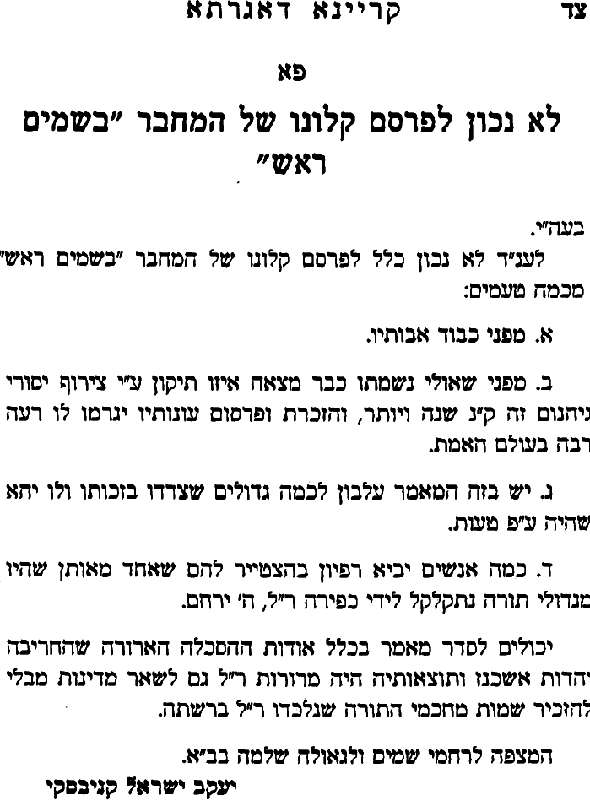
"In my humble opinion it is not at all proper to publicize the disgrace of the author of "Besamim Rosh" for several reasons:Here we have the דעת תורה which basically forbids the Seforim Blog, my blog, and many others. By the way, I happen to agree with some of these points.
"1) Due to the honor of his ancestors (Berlin's family was one of the most elite rabbinic families in all of Europe; his father, brothers, grandfathers, uncles - we're talking the heavyweights).
"2) Perhaps his soul has already achieved it's rectification in Gehinnom, being that more than 150 years had passed. Recalling his sin will cause his soul harm.
"3) This episode brings disdain on many great rabbis who supported the forgery, but were mistaken.
"4) Many men might weaken in their faith due to the confusion caused by their awareness that one who was great in Torah (i.e., Berlin) was able to stumble into heresy, God help us.
"However, it is permissible to compile an essay regarding the accursed Haskalah (here he makes a common pun which can only be seen in Hebrew, Haskalah - enlightenment - with a sin and Haskalah with a samech are homonyms of opposite meaning) which destroyed German Jewry, which departed from its heritage, and also spread to other lands, however the names of those Torah scholars who were caught up in it should be omitted."
Here's a classic excerpt from the כתב יושר:
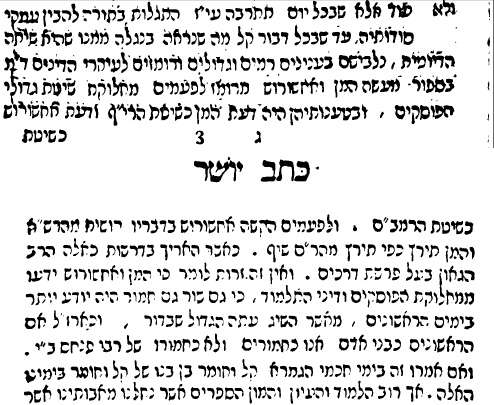
"The actions of Haman and Ahasuerus allude to various disagreements and positions of the great posekim. Haman acted as he did because he held like the Rif, but Achashverosh held like the Rambam. Achashverosh asked like the Maharsha, and Haman answered according to the Maharam Schiff. Don't protest that this is anachronistic, Haman and Achashverosh couldn't know the disagreements of the posekim and the laws of the Talmud, because even an ox and a donkey knew more in earlier times, as we see from the greats of the present generation. Like the Rabbis said, if the earlier ones were like people, we are like donkeys, but not even the donkey of Rabbi Pinchas ben Yair. If this was said by the sages of the Gemara, certainly it applies even more so in these days."
When I happened across this mention in the כתב יושר of a miracle of the Maharal juxtaposed next to another rabbi creating a golem, I was excited. The Maharal's golem is now so embedded in the public consciousness, as we see above, that people simply cannot think of a golem without thinking of the Maharal, and perhaps they can't even think of the Maharal without thinking of the golem. Yet in 1784 (when Ketav Yosher was written) or in 1794-5 (when it was probably posthumously published) the association was obviously not embedded in the mind. I initially wrote Dr. Leiman because I figured he knew which Maharal legend it referred to. Since it's funny, I'll admit publicly that I understood הוריד בירה מן השמים to mean that the Maharal caused beer to descend from heaven for the Emperor Rudolf to drink. I couldn't imagine that בירה here meant castle; the Maharal caused a castle to descend from heaven? What on earth could that mean? Dr. Leiman knew the legend and that it indeed referred to the Prague Castle.
This legend is most interesting. In 1831-32 Julius Max Schottky published a 2-volume book called Prag, wie es war und wie es ist. On pg. 361 we find the following:
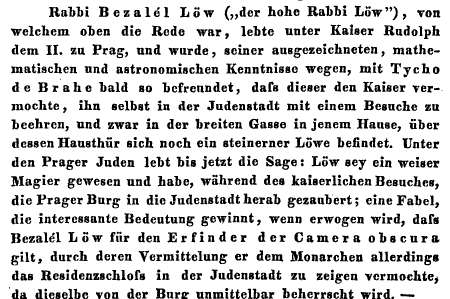
"Rabbi Bezalel Löw ("the tall Rabbi Löw") of whom we've spoken above, lived under the rule of Emperor Rudolph II at Prague, and with his excellent mathematical and astronomical knowledge became such friends with Tycho Brahe that the Emperor could honor the Jewish Quarter with a visit, in the house at the square with a stone lion in front that is still there. Among Prague's Jews there is still the following legend: They say that Löw was a wise magician, and that during the imperial visit he brought the Prague Castle into the Jewish Quarter, by magic. The legend is interesting because Bezalel Low was the inventor of the camera obscura, which was the means through which he could have shown the Monarch the Castle in the Jewish Quarter, which is right outside the Castle. "
Putting aside exactness of the translation, here we see a non-Jewish historian, relating a legend which he says the Prague Jews still told in the early 1830s. The Emperor Rudolph II had such respect for the Maharal that he visited him. As a magician, the Maharal actually conjured the Castle for him right there in the Jewish Quarter (to show his hospitality? I would have thought a beer sufficed, but I guess that's not a miracle for a royal guest). Schottky adds that the Maharal invented the camera obscura, an interesting assertion to say the least, and in his view perhaps the germ of the legend is that he was able to produce an image of the Prague Castle for the Emperor using a camera obscura. An interesting fact from the Wikipedia page: "The term "camera obscura" was first used by the German astronomer Johannes Kepler in 1604." This refers to his book Astronomiae Pars Optica. Look at the to whom Kepler dedicates this work:

In any case, clearly this is the legend which Saul Berlin is referring to, and it seems that the legend of the Maharal being הוריד בירה מן השמים which Schottky reports in the 1830s was in circulation toward the end of the 18th century.
Before I get to other golemic matters, it is interesting to pause and note that not only have no written sources prior to 1836 been found linking the Mahral to the golem, but that once they do appear they are all in German, not in Hebrew. Why is that?
In the first part of the 19th century in Europe there was a Romantic interest in collecting and publishing the oral folklore of the people, for the existence of the rich popular imagination of the masses was thought to be a potent sign of nationhood, and for the first time collectors sought to document it. This is when Grimm's collection of fairy tales were published, and the collection which included a German version of Chad Gadya (see here), with many other examples in the respective European nations. Suffice it to say, this is a 19th century genre. Schottky's recording of the legend of the Maharal and the castle is an example of this. Jews too were swept in by this trend, and they also began to print the folklore of the Jews, the popular legends which had not made it into the existing literature.
See how Berthold Auerbach wrote of whom told the the legend of the golem:
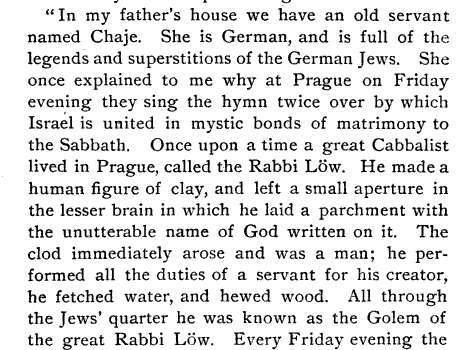
Chaya, the maid, an old woman. It was a bit of folklore, an old wive's tale. Auerbach is one of the first sources to put this story in print, in his 1837 novel Spinoza (above is an English translation from 1882).
The Jewish Romantics, writing in German, got it in the same way the others heard and then wrote down stories like Hansel and Gretel. This is why the story isn't in 'canonical' sources (ala Shu"t Chacham Tzvi) and why it appears exclusively in German in its original printed versions. It is remarkable that a story with such modest and humble beginnings eventually became a fundamental of faith. אל תטוש תורת אמך.
Here is the Chacham Tzvi's famous question concerning a golem:

He mentions that his ancestor (not grandfather) Rabbi Elijah of Chelm (also known as Rabbi Elijah Baal Shem) was reputed to have created a golem using the Sefer Yezira. Not a word about the Maharal. And why should there be? 70 years later the Chacham Tzvi's own great-grandson, Saul Berlin himself, also doesn't mention the Maharal's golem.
The question is, why doesn't Saul Berlin mention his own ancestor, Rabbi Elijah of Chelm, instead of Rabbi Naftali's golem? Here we have to guess, and my guess is that Berlin's own family was off-limits. Yes, he was mocking the concept that rabbis not only can but also did create golems, or more accurately the belief that the remains of a golem could yet be seen today, but he wasn't about to cite his own ancestor and drag him into the satire. Or maybe Rabbi Elijah Baal Shem himself could have been a target, having died 200 years prior, but mentioning him would have just drawn attention to the Chacham Tzvi, his father's grandfather. But I really don't know.
Incidentally, it seems that many believe that Rabbi Elijah Baal Shem was the Chacham Tzvi's grandfather. This is understandable, since he calls him זקני in the aforementioned responsum, and so does his son in Sheilas Yaavetz II.82:
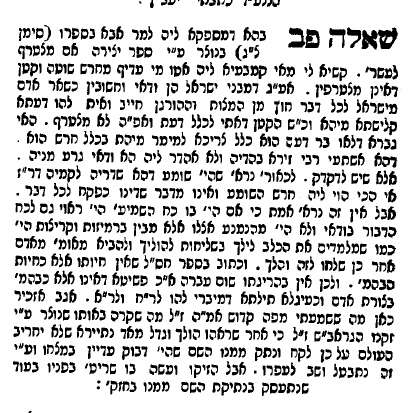
However, think about this logically. How likely is it that Rabbi Elijah (1550-1583) was the grandfather of Chacham Tzvi (1656-1718)? How much older than you are your grandfathers? Are we to believe that the Chacham Tzvi's father was in his 70s when he was born? Not only that, his maternal grandfather, R. Elijah ha-Kohen of Alt-Ofen was born in 1616. That would mean that Chacham Tzvi's father was at least 33 years older than his own father-in-law! So logically this does not make sense, even though the Jewish Encyclopedia has Rabbi Elijah as Chacham Tzvi's grandfather, a mistake repeated in both relevant Wikipedia pages (here and here). It is also repeated in the text and the notes on pg. 150 in the very interesting Artscroll book Great Jewish Letters by Rabbi Moshe Bamberger (which I intend to review). What does Chacham Tzvi's son, Rabbi Yaakov Emden say about this ancestry? On pg. 4 of Megillas Sefer he writes:
אבא רבה הוא הגאון החסיד שבכהונה בעל ס' שו"ת שער אפרים ז"ל, ראש ב"ד בק' ווילנא המעטירה אז בהיות בשלותה, והיה לו כתב יחוסו עד אהרן הכהן, וחתן לאחד מן בני בניו של הגאון ר' אליהו בעל שמ הזקן ז"ל, שהיה אב"ד בקק' חעלם בימים ההם
In fact the Chacham Tzvi's paternal grandfather was married to the grand-daughter of Rabbi Elijah. Regarding Megillas Sefer, see here for a recent entertaining discussion about the provenance of this autobiography.
Next is a really interesting account of a golem. Commenting on Sefer Yezira 2:5, Rabbi Sa'adya Gaon writes the following:
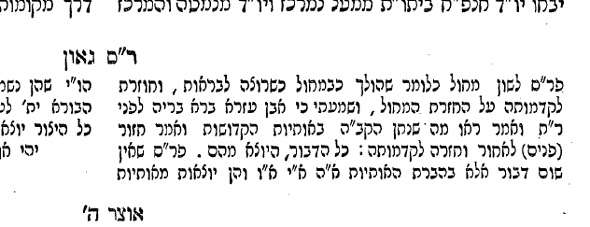
"I have heard that Ibn Ezra created a creature before Rabbenu Tam and said 'See what God allows to be accomplished through his holy letters.'"
Rav Saadya lived 200 years before them you say? Hmm.
Since this is a Maharal post, it is worth glancing at the title page of his תפארת ישראל, published in Venice in 1599 (that is, ten years before the Maharal died):
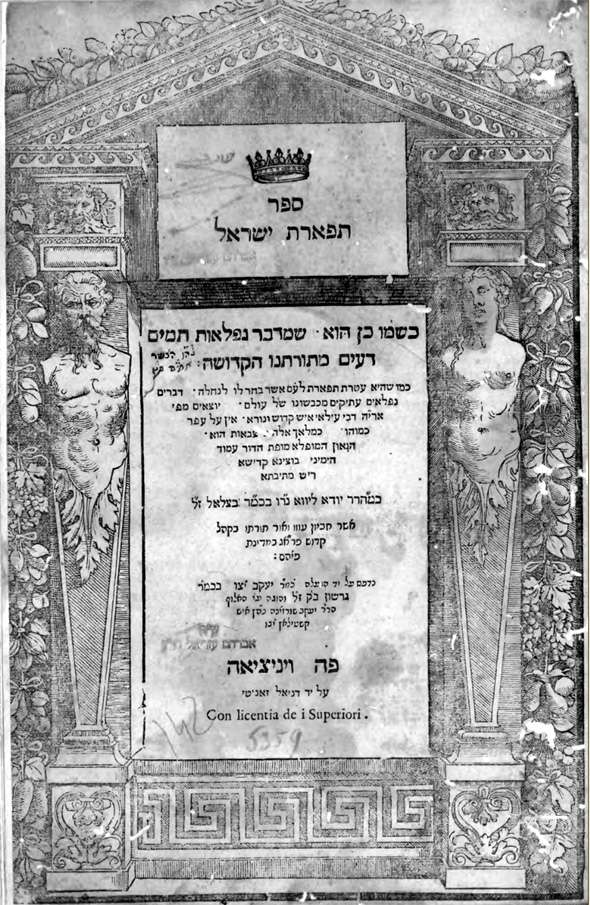
I am not arguing anything about how the Maharal viewed such things, but facts are facts. There are many more such examples of nudes on the title pages of venerable seforim. Not only were they written by important rabbis, but in many cases we know who owned them (and who, therefore, did not deface them). A future post will show an interesting example of one such sefer owned by one rabbi with an extremely zealous reputation.
In 1989 there was a reprint of a commentary on the Torah by Rabbi Menachem Avraham Ha-kohen "Rapoport" (d. 1596).
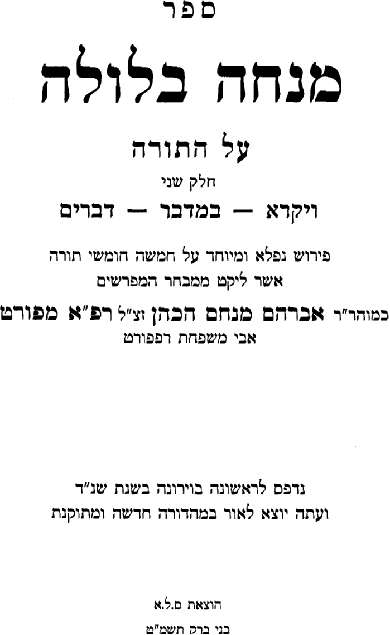
Toward the end of the second volume is a reproduction of the famous coat-of-arms of this family, except that the bare-breasted women are now wearing "shirts" (albeit tight ones!):
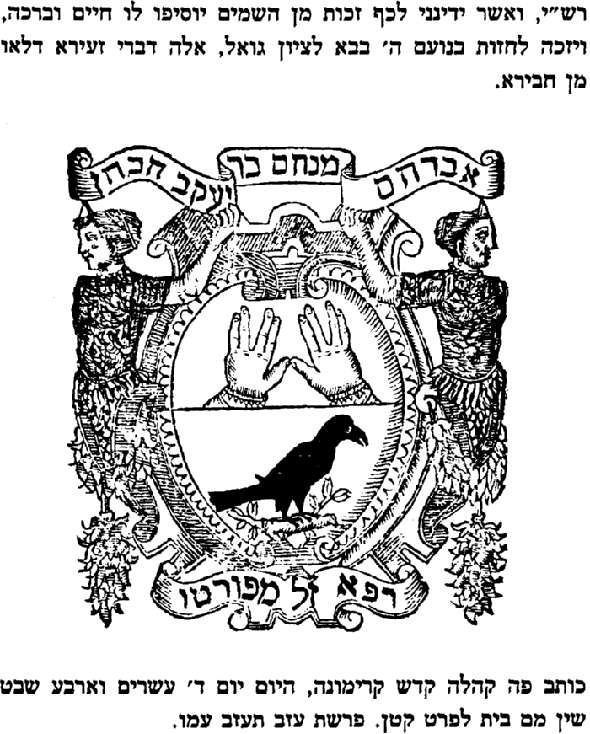
Here is the original, which

From Herald of Destiny by Rabbi Berel Wein:
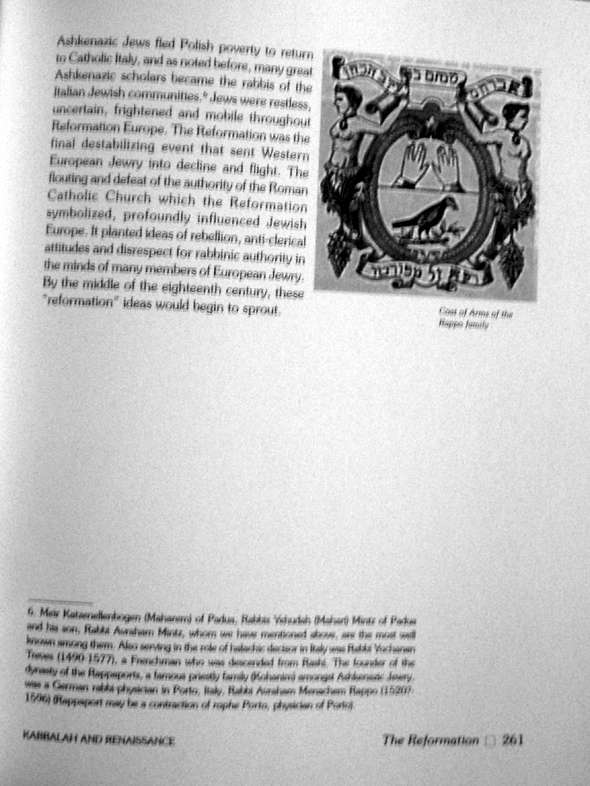
Finally, a note about my discovery of the earliest known source for the Maharal's golem (link). It's a pity (for me) that it wasn't early enough to have made it into the impressive book Path of Life. Rabbi Judah Loew ben Bezalel (cal. 1525–1609). In the relevant article by Byron Sherwin, "The Golem of Prague and His Ancestors" it mentions that for a long time it was thought that the first appearance of Rabbi Loew's golem was in an 1841 article by a non-Jew, with it appearing in Jewish sources beginning in 1847. However, he writes, Shnayer Leiman showed Jewish sources from 1837, and [I forgot!] showed non-Jewish sources from that same year. I showed one from 1836, written by Ludwig A. Frankl, a Jew. I'm under no illusion that this must definitely be the first written source. Earlier ones may yet be found. However the way in which I discovered this should be mentioned. I'm not going to pretend that I printed out pages of the Oesterreiche Zeitschrift für Geschichts und Staatsunde for some light reading. Rather, the discovery is a nice piece of fruit borne out of the digitization of literature. Who knows what truly important discoveries are yet to be found in overlooked literature?





Seforim blog had a whole series on nudes on the frontpages of books. "racy" pictures, is how I think they were described. One day a batallion of armchair shrinks will pyschoanalyze the blogs for focusing on nudes, pretty much the same way we analayze R. Yakov Emden for what he focused on in the MS and elsewhere.
ReplyDeleteDF
I know, but I couldn't really call this (or most especially, the next one I'm going to post about) "racy." It's just nude, not racy. And, actually, that's sort of the point, isn't it?
ReplyDeleteNow I'm waiting for someone to claim that's a man.
Lawrence Kaplan
ReplyDeleteThe Torah sheet proves the opposite of what you claim. Note that the Torah sheet refers to "the well known fact (tale?) that the Maharal created such a being." The fact that the author put "tale?" in a parenthesis after "fact" indicates that sceptical doubts about the Maharal's golem have even penetrated Torah sheets.
Furthermore, as the context clearly indicates, the author does NOT say that the CT's teshuvah mentions the maharal's golem. The author is referring to to the golem created by Rava and killed by R. Zeira.
Nor does the aothr claim tha the Halk zvi
Lawrence Kaplan
ReplyDeleteS. Your translation of Ketav Yosher left out the very important phrase "as has been discusssed at length by the author of Parshat Derakhim." KY is refering to the famous book of Derashot (authored by, IIRC, the Lehem Mishne), where he explains the quarrel between Yosef and his brothers as a halakhic debate as to whether the Avot and Shevatim have the staus of Beni Noah or Jews.
LK, I didn't mean to imply that the author meant to say that the Chacham Tzvi's teshuva mentioned the Maharal's golem, but I did want to call attention to the fact that the author erroneously wrote that Chacham Tzvi was the Maharal's grandson. No doubt this is because of the deeply embedded association of the Maharal with a golem, and it is easy to understand why someone would make the mistake of remarking that the Maharal was his grandfather, since the teshuva mentions his actual "grandfather," a different golem-maker; that's what I was trying to point out. As for the observation that doubts have even penetrated into circles which, say 25 years ago never would have doubted it, this is attested to by the article in the Yated a few years ago, which Dr. Leiman called attention to, and I myself once posted about an Artscroll ad from 2007 which mentions it as "a tradition which has not been established," while copy for a book published in 2000 reads "the illustrious Maharal of Prague is best known as the creator of the famous Golem, but that was hardly his greatest accomplishment." It could be that I make too much of that, but what happened in between 2000 and 2007? I nominate "The Adventure of the Maharal of Prague in London; R. Yudl Rosenberg and the Golem of Prague," Tradition 36:1 (2002): 26-58. This initiated a discussion in the frum community which had scarcely taken place beforehand to the point where the doubt about it has almost become as well known as belief in it. And yet, the association is still most firmly between the Maharal and the golem, and no others.
ReplyDeleteAs for the phrase I left out of KY, I didn't want to point to a specific example. Everyone who reads the parody knows exactly what kind of Torah we're talking about. But I guess it backfired, because instead I just called attention to it.
I remember reading (but cannot locate right now) that the Perashas Derachim is discusses in one of Shir's letters to Shadal. Shir says something like despite the fact that I don't think much of this kind of Torah either, we must respect him for the great work in Magid Mishna or something o that effect.
ReplyDeleteIts fascinating that all these men were all bothered by the same types of things.
This is somewhat off topic, but I found it interesting that the Chacham Tzvi assumes that R’ Zeira held that killing a golem isn’t murder as opposed to assuming that R’ Zeira held that it is murder, but was a murderer and killed it anyway.
ReplyDeleteHa. I was mechaven to Shir. I'll take it.
ReplyDeleteRe anachronism, I don't know if you mean to say that it doesn't bother you, but whether it does or doesn't it's not difficult to understand why people who believe that blinders had been lifted from their eyes, specifically with regard to things like recognizing anachronism, would be so frustrated by such Torah.
G.A.
ReplyDeleteRe: the nudes being men, see Seforim's post on the very literally-illustrated Prague Hagaddah.
http://seforim.blogspot.com/2005/12/racy-title-pages-update-ii.html
The nude woman with long hair (pictured next to the phrase "Shadaim Nachonu USeoraich Tzimeiach") is replaced with a man in a subsequent edition, with the words "Tzuras Ish" above him. A non-sensible illustration trumps a non-tznius one.
Lawrence Kaplan
ReplyDeleteS. I accept your explanation, and am sorry I frustrated your intent. Perhaps you should have added four dots aftee "Maharam Schiff" to indicate an ellipsis.
BTW, was the Parshat Derakhim the Lehem Mishneh or Magid Mishneh? Was his name Yehudah Rosanes. I also BTW, own the recent new edition of Parshat Derakhim.
Lawrence Kaplan
ReplyDeleteIs there any connection between Rav Zeira killing the golem Rava made, and Rava killing Rav Zeira on Purim and bringing him back to life? Perhaps one could say that dead Rav Zeira was like a golem.
IIRC I had brought this in a comment to an ancient post.
ReplyDeleteRe Maharal as creator of a Golem, the Rayatz of Lubavitch was told by his father ZYA to do tikkunim for his ascending to the attic of the Altneuschul in Prague and seeing the remains of the golem.
Additionally, this is the pianuach of a handwritten note of the Lubavitcher Rebbe ZYA (printed in the Kfar Chabad several years ago. I will email it the blogwriter to post online as well):
במענה לקונטרס שמחברו ניסה להטיל
ספק ביצירה הגולם ע"י המהר"ל מפראג כתב הרבי:
בנוגע לס' נפלאות המהר"ל והאגרות וכו' שמזכיר- לא עיינתי בהן ובמילא איני מחוו"ד בזה כלל..
ובנוגע לעיקר הענין (שהמהר"ל עשה את הגולם) – בעצמי שמעתי מכ"ק מו"ח אדמו"ר
שראה הנשאר ממנו – בעליית ביהכנ"ס המהר"ל בפראג. ודיבר עד"ז עם אביו כ"ק אדנ"ע וכו'.
הקושיות שבהמצו"ב על הס' הנ"ל- אין נוגעות כלל בהעיקר, כי מכו"כ עשיריות שנים
לפני ההו"ל של הס' הנ"ל הי' מפורסם בתוך בנ"י שהמהר"ל עשה גולם, ואפילו – אצל
הא"י (=אינם יהודים), ועיין בהס' בהספריות (כמצויין באנצקלפדיות) להחזיר המצו"ב.
הפס"ד בשו"ע: בכל דרכיך דעהו: מה יתוסף אצלו (=השואל שי') בתומ"צ ע"י בירור הנ"ל ?
IIRC the Chida in shem hagedolim (batei kehuna) reports on this coat of arms but does not mention anything amiss regarding the illustrations therein
ReplyDeleteYou write Commenting on Sefer Yezira 2:5, Rabbi Sa'adya Gaon writes... "I have heard that Ibn Ezra created a creature before Rabbenu Tam... Rav Saadya lived 200 years before them you say? Hmm.
ReplyDeleteThe truth is it been proven that it is much later than Rav Saadya written in time period of R. Yehudah Hachassid
I was just being wry. I didn't think I was the one to discover this anachronism.
ReplyDeleteYes, but you overlooked that the author of the work never claimed to be Rav Sa'aday Gaon. Rather he cites or paraphrases a commentary and then also adds his own comments throughout. In this case, for example, the citation from Rav Saadya ends at החזרת המחול.
DeleteI clearly remember my 7th grade Jewish History teacher in Lakewood Cheder telling us that there is little historical proof of the Maharals golem and it most likely never happened.
ReplyDeleteThis would have been in either 1988 or 89.
I think it's proof that R' Saadya Gaon had ruach hakodesh. :)
ReplyDeleteThe Rayatz is one of the least reliable sources of information about historical matters that there is, and he was the source of an enormous number of fantastic tales. (I'm surprised that Dr. Leiman failed to note this is his Seforim post.) I doubt if he ever went up to the attic, and if he did, whether he saw anything. He may have dreamed that he did these things, though.
"IIRC the Chida in shem hagedolim (batei kehuna) reports on this coat of arms "
ReplyDeleteNothing there.
If he could've, he would've.
ReplyDeleteThe real dispute is not whether he created a golem, rather if he could've in which case he would've.
ReplyDeleteMy first comment did not show up until later
ReplyDelete>Nothing there.
ReplyDeleteIt's in his entry for מנחה בלולה, discussing the name. He says he saw it, and also told the Pene Yehoshua about it, but doesn't comment on the image. Not surprising, really, since you practically couldn't move five feet in those days and not see classical style nudes.
No need to post this typo correction:
ReplyDelete"See how Berthold Auerbach wrote of whom told THE THE legend of the golem" -P
I think you're kind of playing the victim by making an equivalence between:
ReplyDelete"In my humble opinion it is not at all proper to publicize the disgrace of the author of "Besamim Rosh" for several reasons:
and
Here we have the דעת תורה which basically forbids the Seforim Blog, my blog, and many others.
Frank
R' Yehoshua Hartman shlita, the foremost expert on Maharal, said that the safek (whether or not there was a golem) should not override the vaddai of the works the Maharal left over.
ReplyDeleteInterestingly, when I went with him to Prague, he told us a frightening story and alluded to the fact that he had seen the golem. I'll tell it if pressed :)
Frank, I don't think of myself as a "victim" at all, but in terms of the language shift your point is taken. Perhaps the issue is that whereas sometimes Daas Torah says that something is "not proper," the administrators of Daas Torah views propose such opinions as "forbidden" and such. I've little doubt that what the Steipler sees as not proper for multiple reasons is seen a definite, binding ruling by many.
ReplyDeleteNosson, while there is no safek, you are of course correct that this matter should not overwhelm the Maharal. In fact it is a shame that so much of the book about the Maharal on the 400th yahrzeit is devoted to what is essentially a distraction, rather than his thought and teaaching (although no small amount is devoted to that as well).
Nosson,
ReplyDeleteyou are hereby being pressed to tell...
"the foremost expert on Mahral"
ReplyDeleteI dont know the rabbi you mentioned, but I doubt very much he is THE expert of Maharal. Every yeshivah has somebodywho likes Maharal, that the discriminating 19 year olds therein proclaim as an expert
If you don't know the rabbi and you don't know the commenter (you know he's 19? - or a he?) then what position are you to comment like that?
ReplyDeleteBy the way, I came across a description of the golem legend printed in "The Maharal" by Yaakov Dov Shulman, CIS Publishers 1992, pg. 193 in Ch. 25 "Thaddeus and the Golem":
"The constant retelling of the story of the Maharal's phenomenol powers makes it hard to ignore, although no one is sure of its authenticity. According to the popular tale, as told in Niflaos Hamaharal by Rabbi Yudel Rosenberg (Pietrokov 1909) the story was as follows . . . "
Rav Hartman is quite an expert, having written annotated works on the gamut of the Maharal's Seforim. He also has strong ties with the foremost students of Rav Hutner, who popularized many of the Maharal's teachings.
ReplyDeleteLawrence Kaplan
ReplyDeleteAnonymous: I agree with S. Since you are unfamiliar with Rabbi Yehoshua Hartman and his important work on the Maharal, why are you commenting? FTR, Rabbi Hartman has edited with extensive annotations the entire Gur Aryeh, the Tiferet Yisrael and other works of the Maharal. The very fact that you are unfamiliar with his now standard editions indicates that you are unfamiliar with Maharal.
You owe both Nosson Gestetner and Rabbi Hartman an apology.
That said, it woud have ben better had Nosson Gestetner referred to Rabbi Hartman as one of the foremost experts on the Maharal.
S: "It's in his entry for מנחה בלולה, discussing the name"
ReplyDeleteI couldn't find any entry for that sefer in the Shem Hagedolim on Hebrewbooks.
Enter this into Google Books:
ReplyDelete"מנחה בלולה" azulai
"If you don't know the rabbi and you don't know the commenter (you know he's 19? - or a he?) then what position are you to comment like that?"
ReplyDeleteYou and Lawrence Kaplan are right. I apologize.
RB Wein told me many times that he fought very hard with artscroll for many of those pix.
ReplyDeleteLawrence Kaplan - I *did* refer to him as the foremost expert on Maharal!
ReplyDeleteHe told us that right after the collapse of the Soviet Union, he and Rav Moshe Schapiro went to Prague, and went to the Altneushul, and were learning Maharal there very late at night.
There was a very loud clattering sound outside the Altneu shul, and the banging source moved around half the shul, and when it reached the door, the door crashed open, and there was an abnormally large man stood there (over 7 foot, very broad shouldered), with odd facial features, and very oddly dressed. He walked in with an odd walk, walked to the Aron HaKodesh at the front, straightened seats in front of the Rav's seat at the front, and left, all the meanwhile ignoring R' Hartman saying "Hello, can we help you" in all languages, including Czech and Hebrew.
R' Hartman asked R' Moshe Schapiro what they'd just witnessed, to which R' Moshe replied: "Who knows. But we are the first people to learn Torah here for hundreds of years."
R' Hartman didn't explicitly say he saw the Golem. But it was bizarre. The banging description matches the attic entrance on the outside, across from the side with the entrance.
He told us this after a 2 hour Maharal shiur at 1am. It was unreal :)
Was there a campfire and marshmallows too? :)
ReplyDeleteNope :) I sent you an email btw, did you get it?
ReplyDeleteS,
ReplyDeleteI got it - thanks.
[You've erred in stating that he told the PY about. He told the PY something else entirely, that another Sefardic Rappaport was of Ashkenazic lineage.]
"It was unreal"
ReplyDeleteIndeed
DF
ReplyDeleteYou know, Fred, above you said you were waiting for someone to claim the nude pictures were of men. Upon - ahem - rather close inspection, it is possible the pictures are of men with strong pectoral muscles. I grant you the fact they were dressed up in the censored version supports that they are women, and I grant you it sounds like apologetics, but still . . . no?
DF
DF: No. :)
ReplyDeleteFirst of all, it's a woman since it's Minerva. (And that's Mars to the left ; wave and say hi.)
Secondly, if you go to JNUL (where I got the image) and make it larger, you'll see it's a woman.
Regarding lomdish, Halachic interpretations of Biblical narratives, it must be acknowledged that the Gemara itself engages in this sort of thing, e.g. the discussion in Yevamos 76:-77. about King David's yihus, and the really strange account in Sandedrin 19: about the one hundred פלשתי foreskins being used for קידושין.
ReplyDeleteI suppose one can argue that at least there, we're talking about Gedole Yisrael, not Haman and אחשורש.
I am not sure Saul Berlin necessarily made such a distinction between the pilpul he disliked and pilpul in the Gemara. Barring that, he may have in fact held in mind some sort of distinction, which is really not so uncommon, wherein that which is in the Gemara cannot be criticized, but all else can. Or, as you imply, he may not have felt that it was anachronistic to place halachic discussion in the mouths of people like King David.
ReplyDeleteIt should be clarified that Rav Hartman is a great expert on Maharal, but from within a particular worldview i.e. as a devotee of Maharal - just like Rav Moshe Shapiro (although perhaps not as extreme). L'mashal, I'm sure the biggest expert on the Lubavitcher Rebbe is a Chabadnik, but you still wouldn't trust his assessments of him.
ReplyDeleteThanks for all your good info.about the Golem first apperances in print.
ReplyDeletehowever ...
in fact at this monent there is no evidence whatever that the maharal and the golem story was known to anybody before november 1836 when as you had discovered the story was published in an Austrian Journal..
and it is very likely that the publication of that story was connected to the publication of the novel Spinoza by B. Auerbach just a few months latter where the first well known of the golem and the Maharal story appeared,
it likely that the story is the original invention of Auerbach and had no Prague connections before him.
in my poinion it likely that Auerbach had already publishes that story independently in some literary journal several years befor that as the story does not seem to be organicaly connected to "Spinoza" and it well worth to search for it.
if there is such original publicaton of the golem story by Auerbach it very likly the original and first version of the maharal and the Golem story anywhere.
SEE
who created the Golem of the mharal of Prague
http://www.notes.co.il/eshed/60482.asp
At this moment I think the Auerbach angle is a question mark, at best. It is possible that the story originated with him, and Frankl somehow heard it from him, or even read an early draft of Spinoza or some such thing, but at the moment we have no evidence that Auerbach was first.
ReplyDeleteIt is not clear when Auerbach book was published at 1837. it could have been at January
ReplyDelete2 months inly after Frenkel spublication and it could havb at Decenber or at the middle.
but we can bot agree that at November 1836 his book was finishd and ready for publication.
books remember are taking a several months or a year or more of preperations for printing before the actual publication in contrast to journal articles.
so we can safely say Auerbach story was written first.
by the way in H.L. Gordon, The Maggid of Caro, (New York, 1949, p. 176. he tells that in his childhoud at Vilna there were stories there that the Vilna Gaon’s Golem rested in the Great Synagogue in Vilna .
ReplyDeletesimilar stories exist of cours in Prague about their Golemn .But such traditions were elso in Chelm about their Golem remains according to memeories in
ספר הזכרון לקהילת חלם : מ' שנה לחורבנה / תל-אביב : ארגון יוצאי חלם בישראל ובארה"ב, תשמ"א 1981
/
So which was first?
Gordon tells us that his father Elija Gordon who was grand rabi of Vilna confirm to him the exitence of the tradition when he was a child probably at the beggining of the 20 century.
so it must have been a long exiting tradition .
about the prague story of the Golem remains in the Synagogue there we here about it for the first time in 1864 in the editor notes for MEGILAT YUCHASIN .
My opinion is that the Vilna story was the first.
the Vilna Gaon’s and the golen story after all was known to all from 1818 at least and about it there is no question .
The prague story on the other hand dosent seems to exist before the 30s of the 19 century.
The probality is that it was copied from a real Vilna tradition about the Gaon and his golem.
>so we can safely say Auerbach story was written first.
ReplyDeleteWe can only safely assume it if it's our pet theory and we want to maintain it even in the face of contrary evidence. Until we see a dated or datable manuscript that's earlier, we can't just assume that Auerbach was the first to write it down, much less create it.
I agree with you that it doesn't appear in writing until the 1830s (unless of course in the future we find an earlier reference), and that several opportunities to mention the golem in relation to the Maharal were missed prior to this, which suggests that the legend didn't exist or was not widely known. Thanks for the additional info.
Also, Eli, I don't understand why on the one hand you simply dismiss the memory of one who claimed to have heard it in 1835 (as you commented at the Seforim Blog) but then on the other hand you're giving so much credit to the claim of another that in his childhood golem stories were told in Vilna (in the early 20th century no less) and since his father told it to him "it must have been a long tradition" and that this is some kind of evidence, to buttress an 1818 mention of a connection of the Gra and a golem (I assume you mean his childhood attempt to create one?) and that this is more credible than the other memory?
ReplyDeleteI apologize for being a little bit harsh in calling Auerbach as the creator in his Spinoza your "pet theory." After all, your speculation about when the story was written is reasonable, but far far from proved. After all, Auerbach's book could have been published in January 1837 as you posit, but it also could have been published in December of 1837.
Still..
ReplyDeletethe process of publishing books then as now of the publisher reviweing a book and agreeing to publish it and the printing it couldent have been less then 8-12 months.
and the writing itself of the book by the author?
again at the very least 8-12 months.
So if Spinoza was published at the latest of December 1837 ( and it could very well be published months before that ) it should have been at the hands of the publisher at January -february 1837.
At the latest.
and the book itself should have been worked on at 1836.
At the latest .
frankly I cant see how the story by Auerbach could have been written latter then November 1836.
These estimates are a little speculative, are they not?* In addition, who is to say that Auerbach didn't add this part in late? It's not an integral part of the book; surely other kinds of kabbalistic miracles could have been used in its stead.
ReplyDeleteBut I'm not actually arguing any of those things, because the point is that we don't know one way or the other. I'm not saying that Auerbach knew it from Frankl, or that Frankl surely did not know the legend from Auerbach himself. Maybe either one heard it from the other. But there's no proof either way. In fact, I am also not saying that either heard it from the other, since it may well have been a real legend (that is, not invented by either of them). The point is that we don't have proof for who wrote it first, but we have proof for when it made its first appearance in print - that is, until an earlier source is discovered which may yet happen.
All I'm saying is that you appear to think you've already solved the mystery, namely that Auerbach himself invented it, and that any contrary indications needs to be explained away in light of the idea that Auerbach made up the story. Will you say that if something turns up from 1834? What about 1833?
IF a document of the legend will be discovered from 1835 1834 1833 etch and by another writer then of course it changes everything.
ReplyDeleteunfortunantly a document from November 1836 dosent changhe my theory because of the too extrame closnes in time of publication to Auerbach story .
IS it realy a concidence that we dont hear anything about the Mharal and golem and suddenly
we find 2 such stories apear one after the other in mater of only few and perhaps very few months?
2 stories both in German by 2 Jewish German writers from similar circles?
to me it look like as almosty unbelivible concidence .
remenbar the Auerbach story about the Golem was comented upon by researchers since 1934 at least.
and nobody had found earlier version of the story despite much research on the subject more of any other Jewish legend till you found one.
apperantly it is very very hard to find such earlier version.
however the "earlier" version is only earlier by a few months so it it is very very possible that the 2 versions were actually connected.
This is how the Meiri comments the passage of Tractate Sanhedrin 65b about the Golem created by Rava:
ReplyDelete"A deed of magic is sorcery and a deed done by natural means is not sorcery. Even if it will be known how to create beautiful creatures not through copulation, as is known in books of natural sciences that such a thing is possible, it is permissible to do so because what is obtained by natural means is not sorcery.
My question is: What books of natural sciences does the Meiri refer to, considering they cannot be the Sefer HaYetzira mentioned in this sugya?
Important news
ReplyDelete) To those who are interest in the golem history at least:
The date of the earliest referrence in print to the maharal and the Golem story had pushed back.
till now the earliest referance was from
Oesterreiche Zeitschrift für Geschichts und Staatsunde, 92, 16 November 1836:
now it was pushed earlier to the year ...
1834
reasercher Cathy S. Gelbin in her book :
The Golem Returns
From German Romantic Literature to Global Jewish Culture, 1808-2008
http://press.umich.edu/titleDetailDesc.do?id=1734730
published several months ago had discovered
the version of a Jewish -German writer Gustav Philipson from 1834 in a Jewish magazin called SHULAMIT. This is a ballad called in german THE GOLEM AND THE aDALTeRESS "And describes how the maharal send the golem to find the rason for epidemic among Prague Jews. The one responsible is descovered as adultrous women caught "in the act of sin.
Till the publication of Gelbin book it was known that Gustav Philipson had published a poem about the Golem in 1841 and it was translated to Hebrew in a Austrian Journal CHOCVEY ITZCHAK at 1862. This is the earliest known publication of the Maharal and Golem story in Hebrew,
So for now it seems that Philipson is the original creator of the Maharal and Golem story and the only one in the 19 century to deal with the story more then once.
Gelbin had probably come to her discovery via the Golem entry in the Jewish encyclopedia from the beggining of the 20 century
see
http://www.jewishencyclopedia.com/view_page.jsp?pid=1&artid=334&letter=G
where the Shelomit version is presented as a abridged version of the 1841 work and without date 'and probably that the reason nobody had looked it up till Gelbin.
however I do think that there may be even earlier version in print beyond even the Philipson story As the idea of the golem as catcher of edaltrous women seems too complex for the first ever story about the golem of the Maharal .
i think that there is earlier story perheps by Auerbach in some Jewish magazin from the beggining of the 30s or pehrhaps from the 20s of the 19 century in which was presented the golem and the mahara story for the rirst time in some much simpler version with the GOLEM as mere house serevant and Philipson had developed it from there.
Elisheva Barre:
ReplyDeleteIn regards to the Meiri, the following is from the last paragraph of the Sefer Berith Menuha: “and see that even today a person can make another person without the copulation of a man and a woman but rather through natural means and the influx (ha-hashpa’ah) which aids this.”
In regards to the mention of the Maharal bringing down a palace from heaven I should point out that stories like that are mentioned in Shivhey Ha-Besht and attributed to Adam Baal Shem and which in fact have been traced to a book of Yiddish tales printed in the 17th century where the hero Adam Baal Shem performs his feats in Prague and Vienna in the 1560-70s. See Shmeruk, Sifrut Yiddish be-Polin, 119-146.
Interesting article on Saul Berlin and his Besomim Rosh http://www.oztorah.com/2010/06/saul-berlin-1740-1794-heretical-rabbi/
ReplyDeleteThank you very much for sharing this incredible anecdote.
ReplyDelete